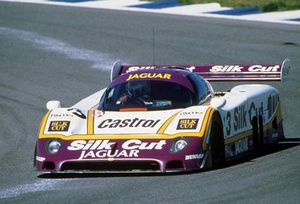.
Jaguar XJR-9

| |
| Jaguar XJR-9 | |
|---|---|
| Jaguar | |
| Production | 1988 |
| Class | Race car |
| Body Style | Closed |
| Length | 189.8 in (4821 mm) |
| Width | 79.5 in (2019 mm) |
| Height | 40.6 in (1031 mm) |
| Wheelbase | 106.7in (2710mm) |
| Weight | 2,315 lb (1050kg) |
| Transmission | 5 speed manual |
| Engine | 7-litre 60º V12 overhead cam, naturally aspirated |
| Power | 745bhp (560 KW) @ 7250rpm 610 lb ft (828 Nm) @ 5500rpm |
| Similar | Porsche 962C |
| Designer | Tony Southgate |
The Jaguar XJR-9 was a prototype race car built for both Group C and IMSA Camel GTP, debuting in at the 1988 24 Hours of Daytona.
An evolution of the design for the XJR-8, the XJR-9 was yet again built by Tom Walkinshaw Racing (TWR), and featured a Jaguar 7.0-litre V12 based on the production 5.3-litre engine from the Jaguar XJS. A variant of the XJR-9, the XJR-9LM, would be developed specifically for Le Mans where the requirement for high straight line speeds on the Mulsanne straight necessitated a low-drag aerodynamic package.
In the United States, the Castrol sponsored XJR-9s debuted at the 24 Hours of Daytona, with the car successfully taking the overall win. However, throughout the rest of the IMSA Camel GTP season the XJR-9 was unable to gain another win until the final race of the season, meaning the team had to settle for 3rd in the constructor's championship. Over in the World Sportscar Championship, the XJR-9, running Silk Cut sponsorship, met with more success. The XJR-9 was able to take six victories, including the 24 Hours of Le Mans, over the eleven race season and clinch another world championship. Jaguar's success at Le Mans marked the first time since 1980 that Porsche had not won Le Mans and the first victory for Jaguar in the 24-hour race since 1957.
For 1989, the XJR-9 was again campaigned in both IMSA Camel GTP and the World Sportscar Championship. However, the XJR-9 was by now dated, and in IMSA was being repeatedly beaten by Nissan, leaving the XJR-9 with only a single win on the season. This led to Jaguar introducing the XJR-10 midway through the season, which met with slightly better success having two wins on the season and usually placing higher then the XJR-9 it ran with. At the end of the season, Jaguar finished 2nd in the championship.
A similar story occurred in the World Sportscar Championship, with Jaguar not able to score a win at all over the entire season against the likes of Sauber-Mercedes. Again, midway through the season the XJR-11 was developed to replace the XJR-9, although both finished out the season. This disappointment led to Jaguar finishing 4th in the teams championship that season.
Within months of Jaguar's 1988 Le Mans victory, TWR would use the XJR-9 chassis for the development of the R9R prototype which, by 1990, had evolved into the Jaguar XJR-15 supercar.
See Also
Error creating thumbnail: Unable to save thumbnail to destination
| ||
| JAGUAR | ||
|
Tata Motors | Jaguar | Land Rover | Hispano Carrocera SA | Tata Daewoo Commercial Vehicle | Daewoo Bus Current Models: XF (R) · XJ (R) · XK (R) Historic Models: X-Type · E-Type · XJS · XKSS · XK120 · XK140 · XK150 · XJ220 · 240 · 340 · Mk. VII · Mk. VIII · Mk. IX · Mk. X · Mk. V · Mk. IV · Mark 2 · Mark 1 · 3.5 Litre · 2.5 Litre · 1.5 Litre · S-Type (1963-1968) · 420 · S-Type · SS100 · XJR-15 Concept Cars: C-XF · R-Coupe · RD-6 · Fuore XF 10 · Pirana Concept · XK180 Concept · F-Type Concept · XK-RR Concept · XK-RS Concept · Concept Eight · XJ Limo Green Hybrid Study Concept · XJ75 Platinum Concept · C-X75 Concept One-Offs: XJ13 Racing Vehicles: C-Type · D-Type · XJR-5 · XJR-6 · XJR-7 · XJR-8 · XJR-9 · XJR-10 · XJR-11 · XJR-12 · XJR-14 · XJR-16 · XJR-17 · XJ-S · R1 · R2 · R3 · R4 · R5 · XKR GT3 · XKR GT2 · RSR XKR GT | ||
| Sir William Lyons | Corporate website | A brand of the Tata Group |
